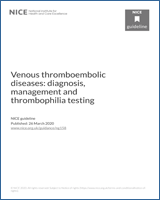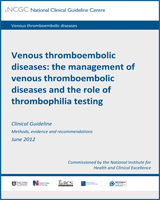2.1. What is a NICE clinical guideline?
NICE clinical guidelines are recommendations for the care of individuals in specific clinical conditions or circumstances within the NHS – from prevention and self-care through primary and secondary care to more specialised services. We base our clinical guidelines on the best available research evidence, with the aim of improving the quality of health care. We use predetermined and systematic methods to identify and evaluate the evidence relating to specific review questions.
NICE clinical guidelines can:
provide
recommendations for the treatment and care of people by health professionals
be used to develop standards to assess the clinical practice of individual health professionals
be used in the education and training of health professionals
help patients to make informed decisions
improve communication between patient and health professional.
While guidelines assist the practice of healthcare professionals, they do not replace their knowledge and skills.
We produce our guidelines using the following steps:
Guideline topic is referred to NICE from the Department of Health.
Stakeholders register an interest in the guideline and are consulted throughout the development process.
The
scope is prepared by the National Clinical Guideline Centre (NCGC).
There is a consultation on the draft guideline.
The final guideline is produced.
The NCGC and NICE produce a number of versions of this guideline:
This version is the full version. The other versions can be downloaded from NICE at www.nice.org.uk.
2.2. Remit
NICE received the remit for this guideline from the Department of Health. They commissioned the NCGC to produce the guideline.
The remit for this guideline is:
‘To produce a clinical guideline on the management of venous thromboembolic diseases, including the use of thrombophilia testing’.
2.3. Who developed this guideline?
A multidisciplinary Guideline Development Group (GDG) comprising professional group members and consumer representatives of the main stakeholders developed this guideline (see section on Guideline Development Group Membership and acknowledgements).
The National Institute for Health and Clinical Excellence (NICE) funds the National Clinical Guideline Centre (NCGC) and thus supported the development of this guideline. The GDG was convened by the NCGC and chaired by Professor Gerard Stansby in accordance with guidance from NICE.
The group met every 4–8 weeks during the development of the guideline. At the start of the guideline development process all GDG members declared interests including consultancies, fee-paid work, share-holdings, fellowships and support from the healthcare industry. At all subsequent GDG meetings, members declared arising conflicts of interest, which were also recorded (Appendix B).
Members were either required to withdraw completely or for part of the discussion if their declared interest made it appropriate. The details of declared interests and the actions taken are shown in Appendix B.
Staff from the NCGC provided methodological support and guidance for the development process. The team working on the guideline included a project manager, systematic reviewers, health economists and information scientists. They undertook systematic searches of the literature, appraised the evidence, conducted meta analysis and cost effectiveness analysis where appropriate and drafted the guideline in collaboration with the GDG.
2.4. What this guideline covers
The guideline will cover diagnostic tests for initial assessment of suspected VTE and interventions to manage venous thromboembolic diseases. Interventions covered include: mechanical interventions, pharmacological interventions, thrombolytic therapy, screening for undiagnosed malignancy in people with spontaneous venous thromboembolism, self-monitoring by patients on pharmacological treatment, information and support for patients and carers, and thrombophilia testing for patients after a previous VTE and for first-degree relatives of people with inherited thrombophilia and venous thromboembolic diseases.
The groups that will be covered include adults (18 years and older) with a suspected or confirmed DVT or PE. Within this population, the following groups have been identified as requiring special consideration: people with cancer, people who misuse intravenous drugs, residents of nursing homes and people with physical disabilities who have restricted movement following a VTE and people with learning disabilities who require long-term medication taken at home.
In addition first-degree relatives of people with inherited thrombophilia and venous thromboembolic diseases will be considered.
Healthcare settings include primary, secondary and tertiary settings.
For further details please refer to the scope in Appendix A and review questions in section 3.1.
2.5. What this guideline does not cover
This guideline does not cover:
Cerebral vein thrombosis
Splanchnic thrombosis
Retinal vein thrombosis.
Groups that will not be covered include:
2.6. Relationships between the guideline and other NICE guidance
Guidance under development
NICE is currently developing the following related guidance (details available from the NICE website)


